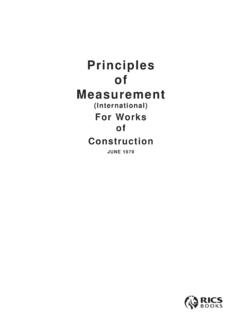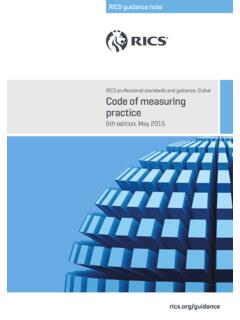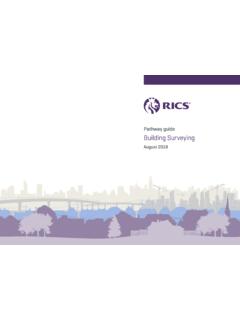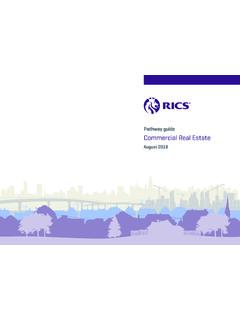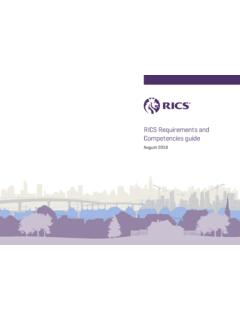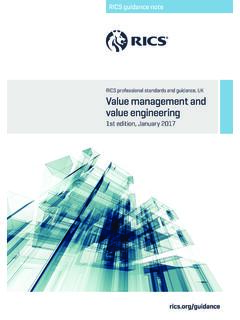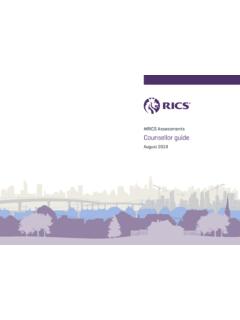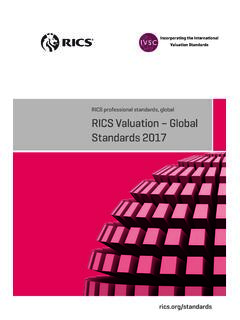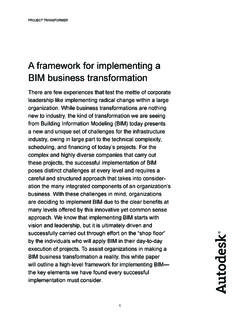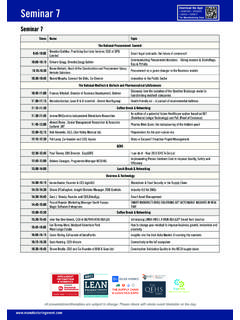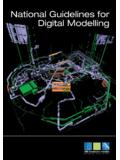Transcription of Pathway guide Planning and Development - rics.org
1 Pathway guidePlanning and DevelopmentAugust 2018 Pathway guide2 Planning and DevelopmentPublished by: RICS, Parliament Square, London SW1P 3AD. All rights in this publication, including full copyright or publishing right, content and design, are owned by RICS, except where otherwise described. Any dispute arising out of this publication is subject to the law and jurisdiction of England and WalesDate published: February 2018 Version guide3 Planning and DevelopmentPlanning and DevelopmentSection oneIntroduction ..5 About the competencies ..5 Choosing your competencies ..5 Where to find help ..5 Section two About the Pathway ..6 About the RICS qualification ..6 Chartered alternative designations ..6 Section threePathway requirements.
2 7 Section fourTechnical competencies guidance ..8 Access and rights over land ..8 Building information modelling (BIM) management ..9 Cadastre and land administration ..10 Compulsory purchase and compensation ..11 Contaminated land ..12 Design and specification ..13 Development appraisals ..14 Development /project briefs ..15 Economic Development ..16 Pathway guide4 Planning and DevelopmentEnvironmental assessments ..17 Housing strategy and provision ..18 Leasing and letting ..19 Legal/regulatory compliance ..20 Management and regeneration of the built environment ..21 Masterplanning and urban design ..22 Measurement ..23 Planning Development and management ..24 Project finance ..25 Purchase and sale ..26 Risk management.
3 27 Spatial Planning policy and infrastructure ..28 Strategic real estate consultancy ..29 Surveying and mapping ..30 Sustainability ..31 Valuation ..32 Pathway guide5 Planning and Development2143 This guide supports the Planning and Development Pathway . It is designed to help you understand more about qualifying in this area. You must use this guide in conjunction with the core assessment documentation which is available on the RICS website and comprises of: Requirements and competencies guide Candidate guide for your RICS assessment, APC, Academic, Senior Professional, Specialist Counsellor can download all the supporting guidance from All RICS pathways are global, though it is appreciated that markets may vary from country to country.
4 If you have any queries please contact your local office. About the competenciesThe RICS competency framework ensures those applying for the RICS qualification are competent to practise and meet the highest standards of professionalism required by RICS. There is a wide range of pathways available to qualify as an RICS professional covering many different areas of practice. IntroductionThe RICS assessment aims to assess that you are competent to carry out the work of a qualified chartered surveyor. To be competent is to have the skill or ability to perform a task or function. The RICS competencies are also based upon attitudes and behaviours. The competencies are presented in a generic way so they can be applied to different areas of practice and geographical locations.
5 It is important that you interpret them within the context of your own area of practice or specialism and location. Each competency is defined at three levels of attainment. You must reach the required level in a logical progression and in successive 1 knowledge and understanding Level 2 application of knowledge Level 3 reasoned advice, depth and synthesis of technical knowledge and its competencies are in three distinct categories:Mandatory the personal, interpersonal, professional practice and business skills common to all pathways and mandatory for all core the primary skills of your chosen optional Selected as additional skill requirements for your Pathway from a list of competencies relevant to the area of mandatory competency requirements are set out in detail in the Requirements and competencies your competencies It is important that you give careful thought to your choice and combination of competencies.
6 Your choice will inevitably reflect the work you do in your day-to-day environment (driven by the needs of your clients/employer). Your choice and combination of competencies will be a reflection of your judgement. At the final assessment interview, the assessors will take these choices into account. They will expect you to present a sensible and realistic choice that reflects the skills needed to fulfil the role of a surveyor in your field of guide should help candidates and employers with a degree of assistance in choosing the competencies that are most appropriate to their area of to find helpRICS has fully trained teams across the globe who will be able to help you with any queries. For details of your local office guide6 Planning and Development2143 The Planning and Development Pathway is a wide-ranging specialist area that is concerned with both the highly strategic policy issues as well as more operational aspects of land and real estate use and Development .
7 The work of Planning and Development Surveyors impacts not only on the physical aspects of the built and natural environment, but crucially too the social, economic and environmental aspects as well. The profession is continually evolving and new areas of practice and associated competencies will emerge, so please make sure you refer to the latest guidance and and Development is of strategic importance as governments and industry are placing more emphasis on the design quality and sustainability of the built environment, urban and rural regeneration, conservation, the impact of IT and big data, climate and demographic change, health, well-being and (even) happiness, transport and sources of renewable energy and related efficiencies.
8 Chartered Planning and Development surveyors play a vital role in identifying and promoting effective land management and administration as one of the primary drivers behind sustainable and Development chartered surveyors work across the globe, adjusting their expertise to the specific Planning and Development cultures, laws and processes that each country or region operates. The client base ranges from local and national governments, Planning authorities and other public agencies, to the private sector such as property companies, house builders, commercial developers, industrial and corporate land owners, special interest groups and the general is their strategic perspective, combined with practicality that allows Planning and Development surveyors to work well with the rest of the profession, as well as other built environment professionals.
9 This underpins their holistic approach to help identify and achieve the world s future sustainable Development qualification The Planning and Development Pathway is ideal for anyone pursuing a career in property who has a particular interest in shaping the built environment through a thorough assessment of future needs and the Planning and Development processes that follow Planning legislation and regulation is applied across most chartered surveying specialisms, this Pathway is aimed at individuals whose main areas of practice are Planning and Development , whether in the public or private sector. The Planning and Development Pathway places emphasis on at least one of the two Planning competencies and the Development appraisal, which are required to Level 3 in this Pathway .
10 However, as with the other property pathways, a broad base of experience in general property and some aspects of construction practice is also undertaking the Planning and Development Pathway may gain their experience either in the public or private sector or in a mixture of alternative designations All candidates qualifying through this Pathway will be entitled to use the designation Chartered Planning and Development Surveyor .About the pathwayPathway guide7 Planning and Development2143 Pathway requirementsLevel 3 Development appraisals Planning and Development management or Spatial Planning policy and infrastructure Level 2 Legal/regulatory compliance Valuation (or Level 3*)Level 1 Measurement Surveying and mappingCoreLevel 3 Ethics, Rules of Conduct and professionalismLevel 2 Client care Communication and negotiation Health and safetyLevel 1 Accounting principles and procedures Business Planning Conflict avoidance, management and dispute resolution procedures Data management Diversity, inclusion and teamworking Inclusive environments SustainabilityMandatoryTwo to Level 3.
